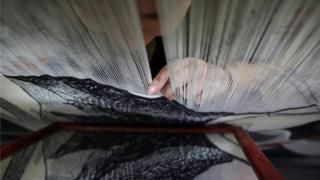 Image copyright Reuters
Image copyright Reuters For three centuries the descendants of Flemish master weaver Jacob van der Goten pulled the strings at Spain's historic Royal Tapestry Factory.
It was here that Francisco de Goya painted cartoons for tapestries destined for Spain's royal palaces.
But all that has changed and Van der Goten's heir, Livinio Stuyck, has been told he is an illegal squatter in its palatial premises in central Madrid.
For every week he refuses to leave his luxury flat inside the building, he faces tens of thousands of euros in fines.
Rent-free life in a palace
The dispute between Mr Stuyck and the Spanish government dates back to the years before the 2008 economic crisis that knocked 9% off Spain's GDP in five years.
Mr Stuyck was the last private owner of the tapestry workshop. It had been passed down in the same family ever since Jacob van der Goten was brought to Spain from Antwerp by King Philip V in 1720.
But in 1997, when the workshop was revealed to be bankrupt, the Spanish national government and Madrid authorities clubbed together to inject close to €2m (£1.7m; $2.2m) into it.
The Royal Tapestry Factory became a publicly owned foundation, with Mr Stuyck in charge.
What no-one seemed to notice was that he carried on living in a 700 sq m (7,535 sq ft) duplex apartment, boasting elegant balconies on the palace's two top floors. It was rent-free, with running costs thrown in.
Even when the money ran out again in 2002 and Mr Stuyck was dismissed as the foundation chairman, his living arrangements stayed the same.
Spain's rich tapestry in 300 years
1720: Master weaver Jacob Van der Goten and his six sons are signed up by Spain's Philip V, escaping a castle in Antwerp to evade Flemish authorities
1775-1792: Francisco de Goya paints more than 70 cartoons for tapestries. Most (as above) are now on display as paintings in Madrid's Prado Museum.
1931: After Spain's Second Republic is declared, the workshop loses royal protection and negotiates its future with President Niceto Alcala-Zamora.
1936: Spain's civil war breaks out; Gabino Stuyck seeks refuge with family's tapestries in Belgian embassy, then moves workshop temporarily out of Madrid
1997: Livinio Stuyck, the Royal Factory's ninth-generation heir, hands over ownership to the Spanish government.
2002: He is dismissed as chairman of the Royal Factory Foundation
How a street child became a leading artist
Goya's portraits seen through eyes of a master
Spain's anti-eviction crusader: Ada Colau
"This is a historical anomaly and it's time to put it right," a culture ministry spokesman told the BBC. "This personage has been enjoying a public building as his personal space for 20 years without paying a penny."
The ministry says it asked Mr Stuyck to leave nicely on two occasions, but now it has issued financial penalties aimed at persuading the squatter to move on.
Mr Stuyck will be fined 5% of his home's estimated value each week that he refuses to leave, an amount the authorities have calculated as around €75,000.
When an eviction notice was served in late March, the current manager of the Royal Tapestry Factory Foundation, Alejandro Klecker, explained that despite Mr Stuyck's long family history in the building, he had no legal right to remain there.
"A search was made for property deeds that would support the idea that he has the right to use the apartment. None was found," he said.
Mr Stuyck sees things very differently.
"My family has been here for 300 years. I was born here. I haven't been here for 20 years, but rather 71. It is my home," he told a reporter from Spanish online newspaper El Confidencial.
The BBC tried to contact Mr Stuyck through relatives in Madrid, but he did not make himself available.
While he may prove hard to dislodge, the idea of all that public space in the heart of Madrid has aroused rivalry among the factory's various trustees.
The left-wing council team that took over Madrid city hall after elections in 2015 says its board representative was shocked to discover the wrangle surrounding Mr Stuyck.
"It is because of city hall that this gentleman is being dealt with. We have plans to use all the space at the museum. We asked why this man was living there without anyone doing anything about it. It's inexplicable. The new board reported it to the police," says a spokeswoman for Mayor Manuela Carmena.
It is a complex web likely to require further unravelling.
No comments:
Post a Comment